
In today’s digital world, screens captivate our children’s attention more than ever before. Yet Arabic reading requires the focused attention to letters, harakat, and script direction that digital devices simply cannot fully replicate.
For Arabic-speaking families, there’s a beautiful opportunity to bridge the gap between digital engagement and deep Arabic literacy, creating a love for reading that extends far beyond the screen.

Many Arabic families find themselves navigating two distinct paths. Arabic A families where Arabic is the primary home language risk seeing their children’s spoken fluency never develop into strong reading skills. Meanwhile, Arabic B families may watch their children view Arabic purely as a school subject, disconnected from their everyday lives.
The solution isn’t to abandon technology entirely, but rather to thoughtfully integrate print reading into our children’s digital world. By creating gentle transitions from screen to page, we can help our children discover the unique joy and depth that comes from holding an Arabic book in their hands.

Arabic e-books and reading apps offer wonderful interactive features that can spark your child’s initial interest. The animations, sound effects, and engaging visuals create excitement around Arabic stories.
Once your child enjoys a story digitally, purchase or borrow the physical version. Reading the same beloved story in print reinforces letter recognition and proper script direction.
The physical book grounds digital fun in lasting literacy. Children begin to see the connection between their screen experience and the beautiful Arabic script on paper.

Rather than viewing screens as the enemy, incorporate them into a healthy reading routine. Try establishing a simple rule: “First we read one Arabic story together, then you can enjoy your favourite game or video.”
This approach transforms reading from a chore into a gateway to digital fun. Children begin to associate Arabic reading with positive experiences, and it becomes a natural part of their daily rhythm. The key is consistency when this routine becomes habit, children stop seeing it as a restriction and start seeing it as simply “what we do.”

Today’s Arabic publishers are creating absolutely stunning picture books that can genuinely compete with digital content. These aren’t the simple books of previous generations they’re works of art that capture children’s imagination.
Look for books with vibrant, eyecatching illustrations that draw children in from across the room. Bright colours create immediate visual appeal.
Books with different textures, raised surfaces, or fabric elements provide sensory experiences that screens cannot match.
Interactive elements like flaps, pop-ups, and moveable parts make reading an active, engaging experience that children remember.

Children learn more from what they observe than what they’re told. When they see their parents genuinely enjoying Arabic books, reading transforms from a childhood requirement to a lifelong pleasure that adults value.
Establish a daily 15-minute family reading window. Choose a time when everyone can participate without rushing.
Parents read their own Arabic books or newspapers while children read theirs. This shows that reading is valuable for all ages.
After reading time, briefly share what you’ve read. This creates connection and shows that Arabic content is worth discussing.

Our website (www.TheMajlisAcademy.com) offers carefully structured pathways and graded readers. We provide systematic
progression through Arabic literacy skills, making learning feel like play.
Our platform excels at providing immediate feedback and adapting to your child’s learning pace. It can be a particularly powerful tool for building confidence in early literacy skills.
However, always pair digital learning with offline practice. The tactile experience of holding Arabic text, feeling page textures, and physically tracking words with fingers creates neural pathways that screens alone cannot establish.

Begin with just 10 minutes of Arabic reading daily. Choose a consistent time that works for your family’s schedule.
Designate a cozy reading corner with good lighting, comfortable seating, and easy access to Arabic books.
Use visual reminders and gentle consistency. Celebrate small wins and be patient as the routine establishes itself.
Once reading becomes natural, gradually introduce variety: different genres, longer books, or family reading discussions.
If Arabic is your primary home language, use reading time to maintain Arabic’s central place in your household routine. This prevents the gradual shift towards other languages that many families experience. Focus on diverse genres and age-appropriate complexity to
match your child’s growing Arabic vocabulary.
If Arabic feels more like a school subject in your home, your participation as parents becomes even more crucial. When you read Arabic materials yourself, you demonstrate that Arabic has value beyond academic requirements. Start with visually engaging books and don’t worry about perfect pronunciation your effort matters more than perfection.
The goal isn’t to eliminate screens but to weave Arabic print into daily life, making it as natural and rewarding as digital play.
Remember that this journey is about creating lifelong readers, not perfect ones. Every page turned, every story shared, and every moment spent with Arabic books builds your child’s connection to their heritage and develops crucial literacy skills.
Start where you are, use what you have, and do what you can. Your consistent, loving efforts will create readers who see Arabic not just as a language to learn, but as a treasure to explore throughout their lives.
Take the first step today: Choose one Arabic book to read together this evening. Let this be the beginning of your family’s beautiful reading adventure.